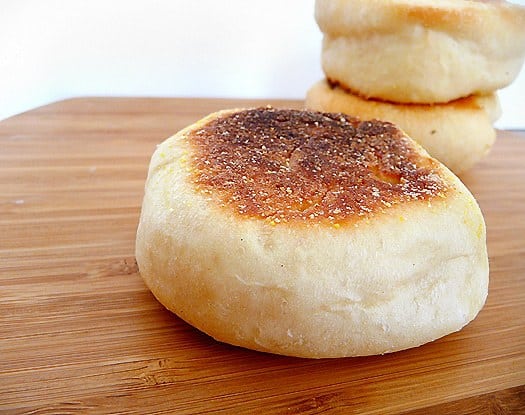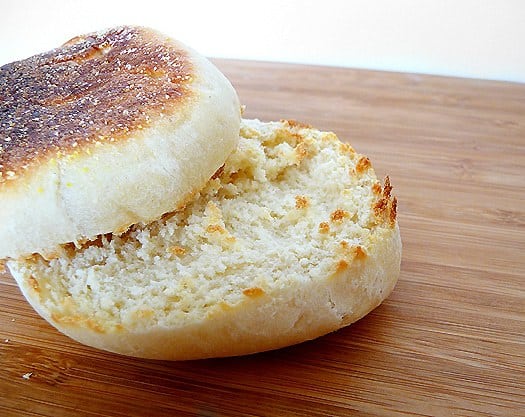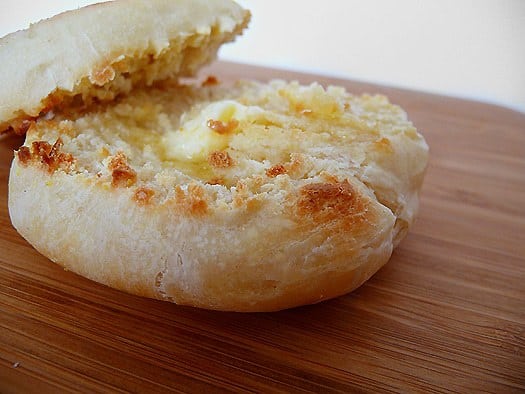English Muffins
The process for making English muffins is very simple – you mix up the dough, which is strikingly similar to that of a basic bread dough, and you let it rise. Then you divide the dough into six pieces, shape into balls, and let them rise. Once they have doubled in size, the fun begins. English muffins actually start baking on the stoveop – a skillet or griddle (I used a cast iron skillet) is used to brown the muffins on both sides, and then they are moved to the oven to finish baking. Total baking time is less than 25 minutes – not too shabby! Since they are fairly small, the muffins cool pretty quickly – you’ll be gobbling up butter-and-jam slathered English muffins before you know it!
Is there a food that you never thought about making from scratch?
English Muffins
Makes 6 English muffins
2¼ cups (10 ounces) unbleached bread flour
½ tablespoon (.25 ounce) granulated sugar
¾ teaspoon (.19 ounce) salt
1¼ teaspoons (.14 ounce) instant yeast
1 tablespoon (.5 ounce) shortening or unsalted butter, at room temperature
¾ to 1 cup (6 to 8 ounces) milk or buttermilk, at room temperature
Cornmeal for dusting
1. Stir together the flour, sugar, salt, and yeast in a mixing bowl (or in the bowl of an electric mixer). Stir in (or mix in on low speed with the paddle attachment) the shortening and ¾ cup milk until the ingredients form a ball. If there is still loose flour in the bowl, dribble in some of the remaining ¼ cup milk. The dough should be soft and pliable, not stiff.
2. Sprinkle flour on the counter, transfer the dough to the counter, and begin kneading (or mixing on medium speed with the dough hook). Knead the dough for about 10 minutes (or mix for about 8 minutes), sprinkling in more flour if needed to make a tacky, but not sticky, dough. It should pass the windowpane test and register 77° to 81° degrees F. Lightly oil a large bowl and transfer the dough to the bowl, rolling it to coat it with oil. Cover the bowl with plastic wrap.
3. Ferment at room temperature for 60 to 90 minutes, or until the dough doubles in size.
4. Wipe the counter with a damp cloth and transfer the dough to the counter. Divide the dough into 6 equal pieces of 3 ounces each. Shape the pieces into boules (or round rolls). Line a sheet pan with baking parchment, mist the parchment lightly with spray oil, and dust with cornmeal. Transfer the balls of dough to the sheet pan, spacing them about 3 inches apart. Mist them lightly with spray oil, sprinkle them loosely with cornmeal, and cover the pan loosely with plastic wrap or a towel.
5. Proof at room temperature for 60 to 90 minutes, or until the pieces nearly double in size and swell both up and out.
6. Heat a skillet or flat griddle to medium (350°F if you have a thermometer setting). Also, preheat the oven to 350°F with the oven rack on the middle shelf.
7. Brush the pan or griddle with vegetable oil or mist with spray oil. Uncover the muffin rounds and gently transfer them to the pan, sliding a metal spatula under them and lifting them to the pan. Fill the pan so that the pieces are at least 1 inch apart, not touching. Cover the pieces still on the sheet pan with the plastic wrap or a towel to prevent them from developing a skin. The dough that is being cooked will flatten in the pan and spread slightly, then the pieces will puff somewhat. Cook them for 5 to 8 minutes, or until the bottom of the dough cannot cook any longer without burning. The bottoms should be a rich golden brown; they will brown quickly but will not burn for awhile, so resist the temptation to turn them prematurely or they will fall when you flip them over. Carefully flip the pieces over with the metal spatula and cook on the other side for 5 to 8 minutes in the same manner. Both sides will now be flat. When the dough seems as if it cannot endure any further cooking without burning, transfer the pieces to a sheet pan and place the pan in the oven (don’t wait for the still uncooked pieces, or the ones just out of the pan will cool down and will not respond to the oven stage). Bake for 5 to 8 minutes on the middle shelf in the oven to ensure that the center is baked. Meanwhile, return to the uncooked pieces and cook them, then bake them, as you did the first round.
8. Transfer the baked muffins to a cooling rack and cool for at least 30 minutes before slicing or serving.
Source: The Bread Baker’s Apprentice by Peter Reinhart)




No comments:
Post a Comment